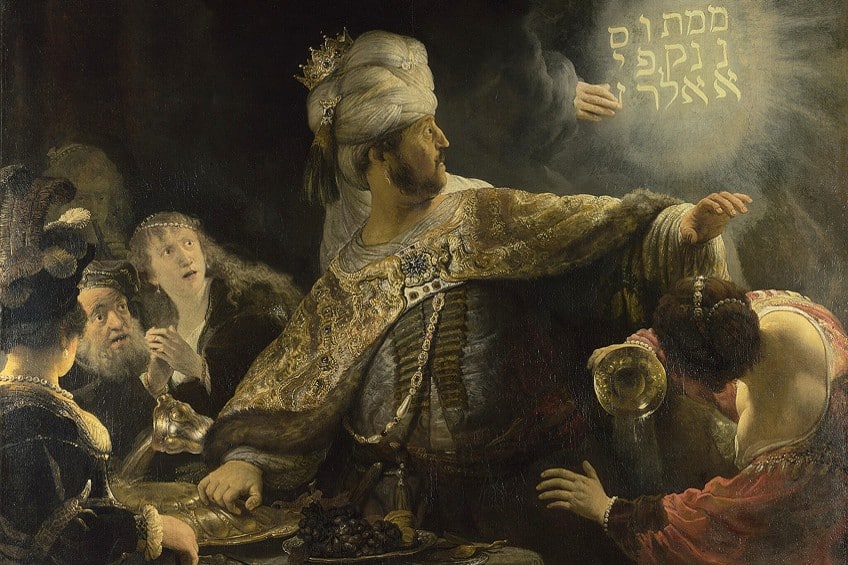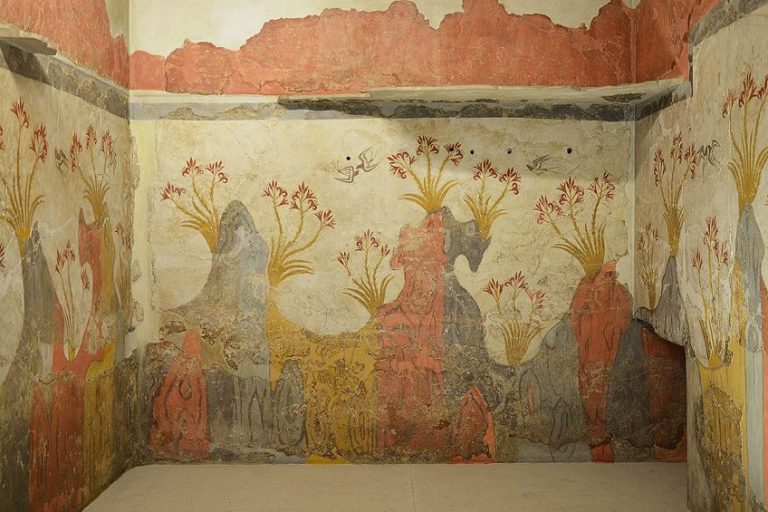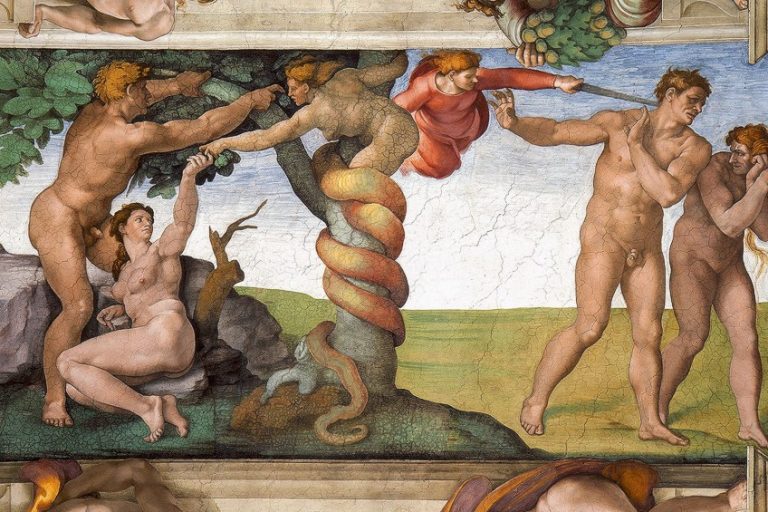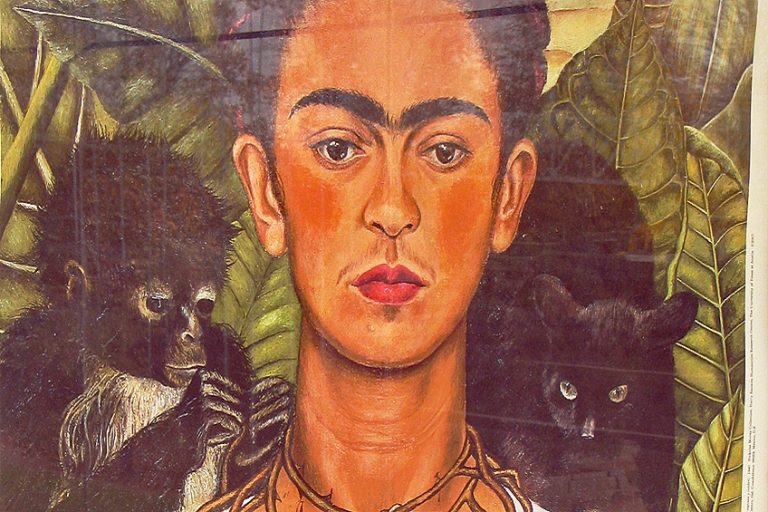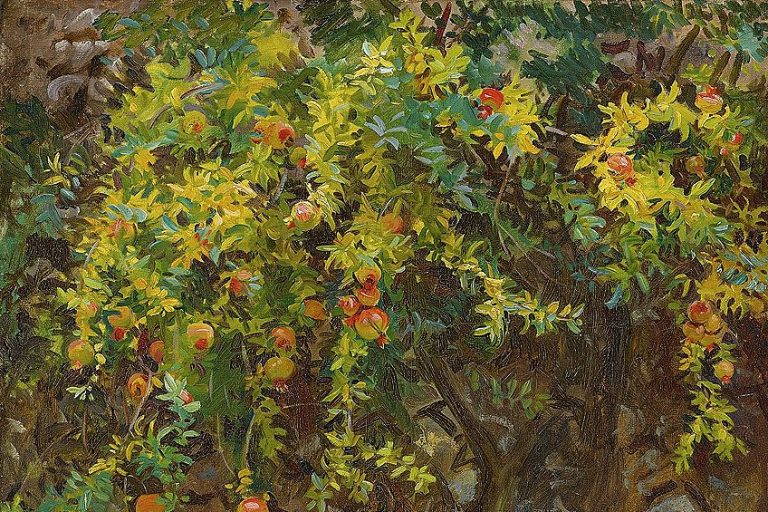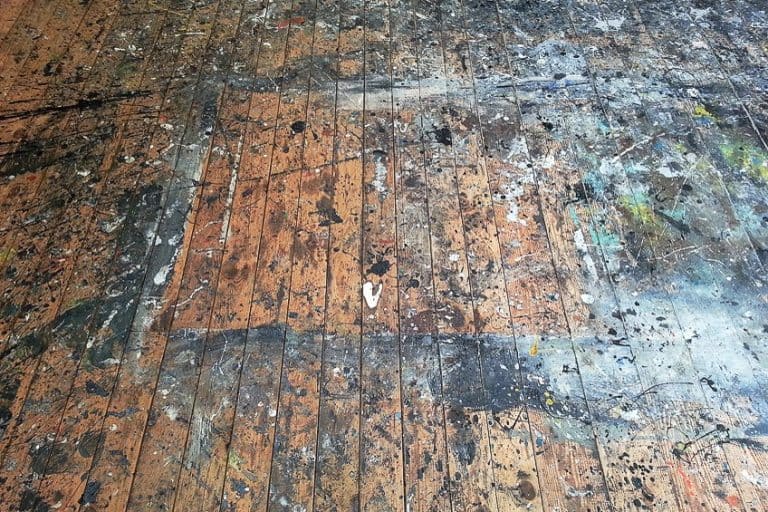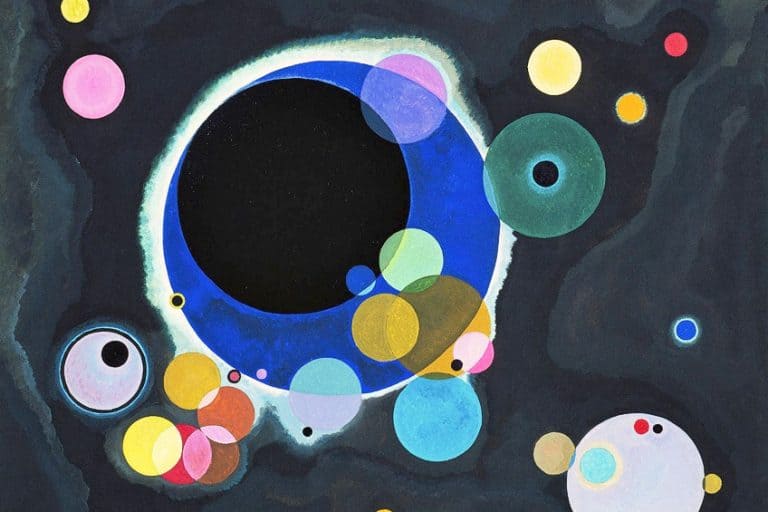“Belshazzar’s Feast” by Rembrandt van Rijn – A Feast for the Eyes
You may know Rembrandt van Rijn from his famous The Night Watch (1642) painting and as one of the leading artists of the Dutch Golden Age. He was known for his naturalistic and artistically skillful renderings of subject matter that ranged from history, mythology, portraits, landscapes, and religious paintings. This article will explore one of his religious paintings, titled Belshazzar’s Feast (c. 1636 – 1638).
Artist Abstract: Who Was Rembrandt van Rijn?
Rembrandt Harmenszoon van Rijn was born in Leiden, Holland on July 15, 1606, and died in Amsterdam on October 4, 1669. He was known for being one of the pioneering Dutch Golden Age artists and painted compositions that ranged from portraits, landscapes, religious, and historical paintings.
His studies included the University of Leiden, however, he soon left and pursued art. Examples of paintings include The Anatomy Lesson (1632), Danae (1636), and The Night Watch (1642).
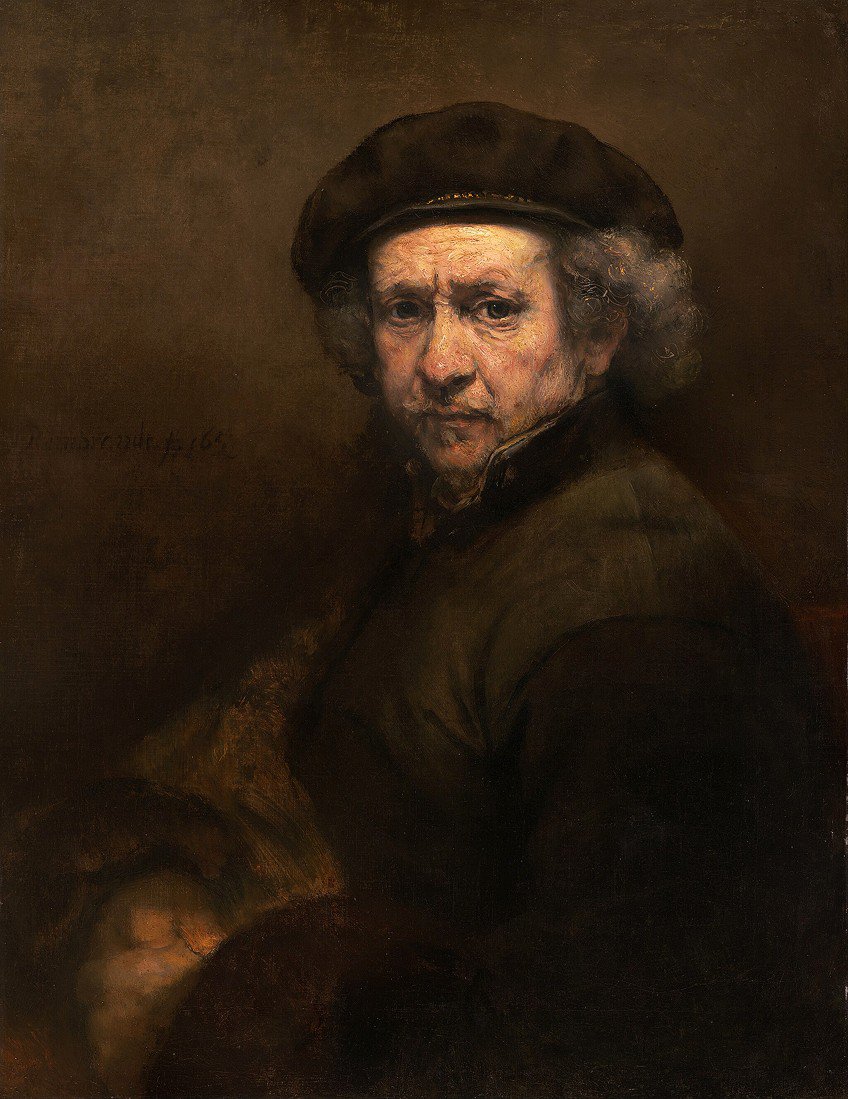
Belshazzar’s Feast (c. 1636 – 1638) by Rembrandt van Rijn in Context
| Artist | Rembrandt Harmenszoon van Rijn (1606 – 1669) |
| Date Created | c. 1636 – 1638 |
| Medium | Oil on canvas |
| Genre | Religious/History painting |
| Period/Movement | Baroque |
| Dimensions (centimeters) | 167.6 x 209.2 |
| Series/Versions | N/A |
| Where Is It Housed? | National Gallery, London, England |
| What It Is Worth | It was bought by the National Gallery, with a contribution from the Art Fund (an independent charity), in 1964. The price is uncertain. |
The article below will discuss Belshazzar’s Feast (c. 1636 – 1638) in more detail, starting with an overview of who Belshazzar was and when Rembrandt painted it. A formal analysis will discuss the subject matter and look at how the scene is depicted, including a look at the artist’s style by how the art elements arrange the piece.
Contextual Analysis: A Brief Socio-Historical Overview
When Rembrandt van Rijn painted Belshazzar’s Feast around 1636 to 1638, he was living in Amsterdam, where he reportedly moved in 1631. His move to Amsterdam opened new doors and opportunities for him. He was in a business partnership with Hendrick Uylenburgh, reportedly from 1631, the latter was an art dealer and owned a portrait painting workshop where Rembrandt reportedly worked for several years, which also qualified to become a member of the Guild of St Luke in 1934.
Who Was Belshazzar?
Before we look at Belshazzar’s Feast painting, let us look at who exactly Belshazzar was and what story Rembrandt found inspiration from. Belshazzar was a Babylonian king from the Bible’s Old Testament Book of Daniel and was believed to be the son or grandson of King Nebuchadnezzar. The latter was known for his defeat over Jerusalem and looting of its temple.
According to Chapter Five in the Book of Daniel, Belshazzar held a feast/banquet for “a thousand of his lords” and utilized the stolen loot, otherwise called the “gold and silver vessels”.
During the banquet, a hand started writing on the wall, and Belshazzar noticed this, and Daniel was brought in to interpret the Hebrew words, which read, “MENE, MENE, TEKEL, UPHARSIN”. These words were translated as “God has numbered the days of your kingdom and brought it to an end; you have been weighed in the balances and found wanting; your kingdom is given to the Medes and Persians”. According to the Biblical story, Belshazzar was killed that same night.

Reportedly, Rembrandt van Rijn utilized models for the figures in his Belshazzar’s Feast painting. For example, the figure of Belshazzar was someone that Rembrandt utilized in other paintings and who also wore the costumes modeled. The woman who is on Belshazzar’s right (our left) was reported as Rembrandt’s wife, Saskia.
She reportedly also modeled for the artist in his painting Saskia van Uylenburgh in Arcadian Costume (1635), which is housed at the National Gallery in London, England.
Some of the inspirations for the figures have also been linked to other artworks, for example, Belshazzar’s pose has been thought to be inspired by The Anger of Ahasverus (c. 1618 – 1619) by the Dutch painter Pieter Lastman. The woman in the lower right corner, for example, has been thought to resemble one of the women in the painting titled Rape of Europa (c. 1570) by Paolo Veronese, who was an Italian Renaissance artist.
Understanding the Written Words on the Wall
The words on the wall in the Belshazzar’s Feast painting have also been the topic of scholarly discussion and debate, notably around the ordering of the words in terms of being in columns or rows. Rembrandt van Rijn depicted the words in Hebrew, which were reportedly inspired by the formula written by Menasseh ben Israel, who was a Rabbi and scholar, and a friend of the artist.
This would suggest an explanation as to why he chose the inscription in his painting.
The inscription was reportedly written from top to bottom (vertical) and right to left, which God’s hand in Belshazzar’s Feast painting by Rembrandt hints at due to the position of His hand. Reportedly, the artist also erred in his transcription of the top left letter, which reads “mem”, but is “samekh”. Both these words share a similar appearing circular symbol.
Formal Analysis: A Brief Compositional Overview
In the formal analysis of the Belshazzar’s Feast painting, you will read more about the subject matter that Rembrandt depicted, which focuses on the moment the ominous words were written on the wall. It will then explore the stylistic details according to the element of art, which will delve deeper into Rembrandt’s artistic skills.

Subject Matter: Visual Description
Belshazzar’s Feast by Rembrandt van Rijn is an emotionally heightened scene, depicting several figures in an interior setting sitting around a banquet table. Belshazzar is the central figure and has stood up from his seat at the table and is halfway facing the wall behind him, where a solitary hand, undoubtedly God’s hand, emerging out of a gray cloud has written the Hebrew words on the wall.
Belshazzar’s appearance is regal, wearing an elaborate cloak and large turban topped with a crown.
Looking at the table and people around it, depicted in the lower left quadrant of the composition, there appear to be four figures, three seated around the table and what appears to be a flute player in the far background, who holds the flute up to his mouth. Is he playing the flute?

In the lower-left corner is a woman with her head away from us, the viewers, she appears to be looking in the direction of a bearded man, who is facing us, the viewers. He, in turn, is looking at Belshazzar. This bearded man appears confused, his mouth is somewhat open, and his eyes are wide. On the bearded man’s left is a woman, who is holding her hands together, and looking in Belshazzar’s direction, to her left. She appears in shock or unsure what is going on and her mouth is also partially opened with widened eyes.
There is another woman in the lower right corner of the composition with her back to us, the viewers. She is leaning far to the side as if recoiling from what is happening on the wall.
Her head and face are also turned in the direction of the wall and she appears to hold a pitcher in her right hand, which is half turned spilling its liquids, and her left hand is held out beside her as she is in a posture of surprise. The contents on the table depict fruit and foodstuff from the gold and silver vessels. The wall, depicted in the upper right quadrant of the composition, is illuminated by the words and the apparent light emanating from it.
Color
Belshazzar’s Feast by Rembrandt van Rijn is known for consisting of a variety of pigments that provide a rich color scheme. Examples include lead tin yellow as seen in Belshazzar’s cloak and the writing on the wall. Blues like azurite have been combined with lead white for Belshazzar’s undergarments/robe. Another blue, smalt, was reportedly mixed with lead white and chalk in the headdress of the woman in the lower left corner of the composition. Other pigments include vermillion, red lake, and yellow ochre.
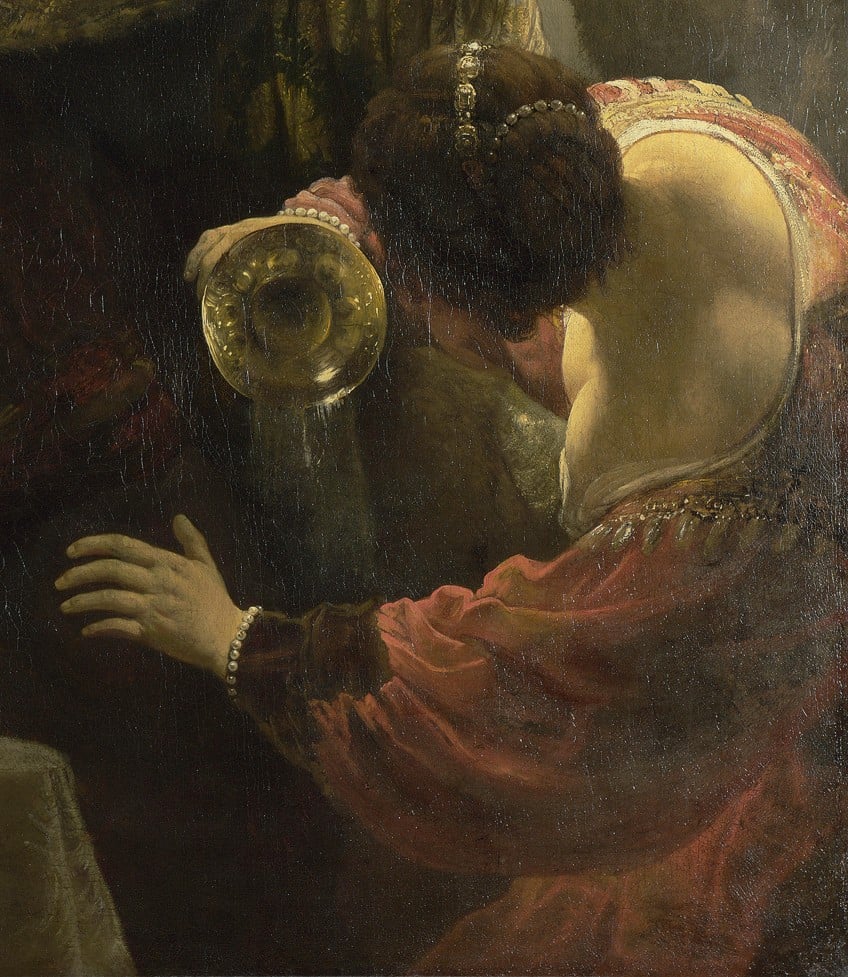
The rich color scheme also creates an implied light source in the composition, for example, notice the colors that create a sense of illumination on the wall on the right as the words are written and the contrast between this and the darker, almost black, background. This also links to the technique known as Chiaroscuro, which Rembrandt van Rijn utilized in his paintings and provided a heightened sense of dramatism and realism.
Texture
Rembrandt van Rijn’s brushstrokes are varied in Belshazzar’s Feast painting, from the physical, or tactile, texture on the canvas, to implied texture. For example, there are impasto applications evident on Belshazzar’s cloak, which are tactile textures created by the paint.
Implied textures are evident, for example, the softer folds of the fabric and the smoother brushstrokes that imply the skin textures.

Line
There are naturalistic, otherwise known as organic, lines in Belshazzar’s Feast by Rembrandt van Rijn, from curved and rounded lines, which create dynamism and fluidity in the composition.

Shape and Form
The shapes and forms that comprise Belshazzar’s Feast by Rembrandt van Rijn are organic and naturalistic and are irregular compared to being more geometric. Some examples include the natural forms of the figures and the various objects, notably foodstuff, on the table.
Some of the shapes evident are the circle on the wall created by the light or the more rounded square-like shape of the corner of the table.
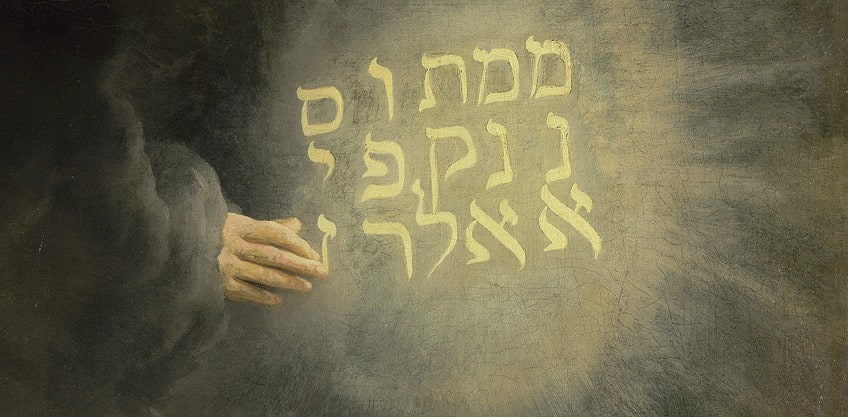
Space
Rembrandt van Rijn created an intimate space in the Belshazzar’s Feast painting. The figures appear close to one another with an indistinct and dark background, which places even more focus on the events happening in the foreground. Furthermore, van Rijn created a sense of spatial depth by depicting the flute player lighter, and the figures more into the foreground appear clearer in view with the larger figure of Belshazzar as the central focal point.

A King As Conduit
Reportedly, the Belshazzar’s Feast painting did not receive the best accolades during its early years and was compared to another painting, also titled Belshazzar’s Feast (c. 1821), by John Martin, which was a large-scale work now held at the Yale Center for British Art in New Haven in Connecticut, United States.
However, Rembrandt’s Belshazzar’s Feast painting has become a chosen visual for pop culture.

Belshazzar’s Feast by Rembrandt van Rijn depicted a so-called cautionary story. One that demonstrated the repercussions of excess, indulgence, and the disrespectful handling of objects deemed as sacred. The king became the conduit for the lesson inherent in the painting’s subject matter.
This article explored Belshazzar’s Feast by Rembrandt van Rijn in more detail and how it was one of his art pieces from his burgeoning time living in Amsterdam. It was also a telling portrayal of a scene rooted in religious symbolism and bedecked with Rembrandt’s realism and stylistic skills. Here, Belshazzar is almost like a conductor, his reaction catalyzes the dramatic reactions around him, as he, himself, is affected by the sudden shock of seeing the writing on the wall.
Frequently Asked Questions
What Baroque Artist Painted Belshazzar’s Feast?
The Dutch artist, Rembrandt van Rijn, painted Belshazzar’s Feast (c. 1636 – 1638). It is an oil on canvas and measures 167.6 by 209.2 centimeters.
What Is the Belshazzar’s Feast Painting About?
Belshazzar’s Feast (c. 1636 – 1638) by Rembrandt van Rijn depicts the story from the Bible’s Old Testament, namely in the Book of Daniel. It is about the Babylonian King, Belshazzar, and his imminent undoing for serving his guests food and drink with stolen goods.
Why Did Rembrandt Paint Belshazzar’s Feast?
It is believed that the Dutch artist painted Belshazzar’s Feast (c. 1636 – 1638) to establish himself as a painter in Amsterdam. It is unclear if he was commissioned to create the painting or not.
Where Is Belshazzar’s Feast by Rembrandt van Rijn?
It is housed at the National Gallery in London, England. It was purchased by the National Gallery in 1964 with so-called contributions from the Art Fund, however, the exact price is uncertain.
Alicia du Plessis is a multidisciplinary writer. She completed her Bachelor of Arts degree, majoring in Art History and Classical Civilization, as well as two Honors, namely, in Art History and Education and Development, at the University of KwaZulu-Natal, South Africa. For her main Honors project in Art History, she explored perceptions of the San Bushmen’s identity and the concept of the “Other”. She has also looked at the use of photography in art and how it has been used to portray people’s lives.
Alicia’s other areas of interest in Art History include the process of writing about Art History and how to analyze paintings. Some of her favorite art movements include Impressionism and German Expressionism. She is yet to complete her Masters in Art History (she would like to do this abroad in Europe) having given it some time to first develop more professional experience with the interest to one day lecture it too.
Alicia has been working for artincontext.com since 2021 as an author and art history expert. She has specialized in painting analysis and is covering most of our painting analysis.
Learn more about Alicia du Plessis and the Art in Context Team.
Cite this Article
Alicia, du Plessis, ““Belshazzar’s Feast” by Rembrandt van Rijn – A Feast for the Eyes.” Art in Context. January 3, 2024. URL: https://artincontext.org/belshazzars-feast-by-rembrandt-van-rijn/
du Plessis, A. (2024, 3 January). “Belshazzar’s Feast” by Rembrandt van Rijn – A Feast for the Eyes. Art in Context. https://artincontext.org/belshazzars-feast-by-rembrandt-van-rijn/
du Plessis, Alicia. ““Belshazzar’s Feast” by Rembrandt van Rijn – A Feast for the Eyes.” Art in Context, January 3, 2024. https://artincontext.org/belshazzars-feast-by-rembrandt-van-rijn/.


